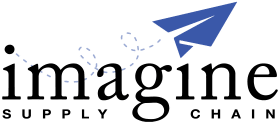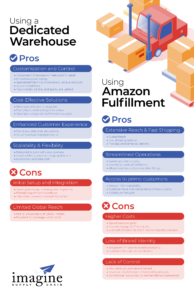At Imagine Supply Chain, we are committed to staying ahead of the curve when it comes to environmentally-friendly packaging options. As we step into 2024, it’s essential to understand the latest trends shaping the industry, especially in fulfillment centers in Salt Lake. From innovative materials to sustainable practices, let’s explore the top trends in packaging solutions this year.
1. Biodegradable Materials
“A biodegradable material can be defined as a material which can be decomposed by bacteria or other natural organisms and not be added to pollution,” says BYJU’S. One of the most significant trends in environmentally-friendly packaging is the shift towards biodegradable materials. Companies are increasingly choosing packaging solutions made from materials like compostable plastics, plant-based polymers, and biodegradable films. These materials break down naturally, reducing the environmental impact of packaging waste.
2. Reusable Packaging
Another trend gaining momentum in 2024 is the use of reusable packaging. Lots of businesses are moving away from single-use packaging towards designs that can be reused multiple times. This trend not only reduces waste but also promotes a circular economy by extending the lifespan of the packages.
3. Recyclable Packaging Innovations
In 2024, recyclable packaging innovations are taking center stage in the quest for more sustainable packaging options. One trend is the development of multi-layered materials that facilitate easier recycling processes. These materials are designed to be separated effortlessly, allowing each component to be recycled easily. For example, a packaging solution may consist of a paper outer layer, with a thin plastic barrier for protection, and a recyclable plastic or cardboard inner layer. By utilizing materials that can be easily taken apart and recycled, companies are reducing the amount of waste sent to landfills and promoting a more circular economy. According to the EPA, “While the recycling of corrugated boxes is by far the largest component of paper packaging recycling, smaller amounts of other paper packaging products also enter the recycling stream (estimated at about 1.8 million tons in 2018).”
On top of this, advancements in recyclable packaging include the use of higher percentages of post-consumer recycled content. By using recycled materials in packaging production, companies reduce the demand for new resources, decrease energy consumption, and lower greenhouse gas emissions. Consumers are increasingly conscious of the environmental impact of packaging, and brands that prioritize recyclability are likely to resonate positively with eco-conscious consumers.
4. Minimalist Packaging Designs
Minimalist packaging designs are gaining popularity in 2024 as companies try to reduce excess waste and create a more aesthetic-looking product presentation. This trend involves simplifying packaging elements to focus on essential features while keeping its functionality and brand identity. By streamlining designs and using less material, companies can limit their environmental footprint without compromising product protection or aesthetics.
One approach to minimalist packaging is the use of thinner materials and better structural designs that maintain durability while reducing overall weight and volume. This not only saves resources during production but also lowers transportation costs and carbon emissions throughout the supply chain. Additionally, minimalist packaging often aligns with consumer preferences for clutter-free, elegant-looking product presentations, enhancing brand perception and customer satisfaction.
5. Smart Packaging Solutions
Innovative technologies are playing a significant role in shaping environmentally friendly packaging options. Smart packaging solutions, such as RFID tags for tracking and monitoring, help optimize supply chains, reduce waste, and enhance overall sustainability efforts.
Fulfillment Centers in Salt Lake: Embracing Sustainable Practices
At Imagine Supply Chain, we understand the importance of sustainable practices in every aspect of our operations, including fulfillment centers in Salt Lake. By using environmentally friendly packaging options and staying updated with the latest trends, we aim to minimize our environmental impact while delivering exceptional service to our clients.
6. Sustainable Supply Chain Collaboration
Collaboration across the supply chain is a huge aspect of promoting sustainable packaging options in 2024. Companies are recognizing the interconnectedness of various stakeholders, from raw material suppliers to logistics providers, in achieving sustainability goals. Collaboration helps the sharing of best practices, innovative ideas, and resources necessary to implement environmentally friendly packaging solutions effectively.
Moreover, sustainable supply chain collaboration helps with transparency and accountability, allowing stakeholders to track progress, measure impact, and continuously improve sustainability initiatives. By working together towards common goals, companies can drive meaningful change and create a more resilient and eco-conscious supply chain ecosystem.
7. Consumer Education and Awareness
In 2024, the importance of consumer education and awareness regarding environmentally friendly packaging options cannot be overstated. Companies are increasingly investing in educational campaigns and initiatives to inform consumers about sustainable packaging choices and encourage responsible disposal practices.
One approach to consumer education is through labeling and certification programs that highlight eco-friendly packaging attributes. Labels such as “recyclable,” “biodegradable,” or “made from post-consumer recycled materials” help consumers make informed purchasing decisions and support brands that prioritize sustainability. Additionally, educational materials, such as online guides, infographics, and videos, are valuable tools for conveying the benefits of sustainable packaging and illustrating proper disposal methods.
Also, companies are leveraging social media platforms, influencer partnerships, and interactive experiences to engage consumers in conversations about sustainability. By creating meaningful content and fostering dialogue, brands can empower consumers to make conscious choices that align with their values and contribute to environmental conservation.
8. Regulatory Compliance and Standards
As sustainability takes center stage in packaging practices, regulatory bodies are creating stricter guidelines and standards to ensure environmental protection and promote responsible packaging practices. In 2024, companies must stay vigilant and compliant with these regulations while proactively seeking eco-friendly alternatives to traditional packaging.
Key areas of regulatory focus include material sourcing, recycling requirements, waste management, and carbon footprint reduction. Companies may need to adhere to specific standards for packaging materials, such as the use of recyclable or compostable materials, and comply with recycling targets set by regulatory agencies.
Innovations in packaging technology, materials, and design play a big role in meeting regulatory standards while advancing sustainability objectives. By staying informed about evolving regulations, collaborating with industry partners, and investing in sustainable practices, companies can navigate the complex regulatory landscape and contribute to positive environmental outcomes.
In 2024, the landscape of environmentally friendly packaging options continues to get better, driven by innovation, collaboration, and consumer awareness. Imagine Supply Chain, a fulfillment centers in Salt Lake, is dedicated to embracing these trends and leading the way toward a more sustainable future. By leveraging biodegradable materials, reusable packaging solutions, recyclable innovations, and smart technologies, we can make a positive impact on the environment while meeting the needs of our clients and partners. Together, we can create a greener, more sustainable supply chain for generations to come. Head to our website for more information.



